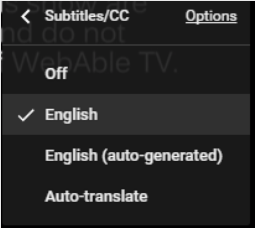Clarity with Captioned Video
Written by Alexis Alexander
April 3, 2017 • 2 minute read
This article will assist you in implementing video content in your curriculum by explaining the importance of captions and how to find properly captioned content online.
Since our students learn in many different ways, it is important to create a course that contains a variety of content, including videos and other types of multimedia.
However, when you add multimedia to your course, it is your responsibility to make sure that this content is accessible to all learners. This means that video content will only be accessible and fully effective if it is properly captioned.
Captions are on-screen text descriptions that display the dialogue, identifies the speakers and describe other relevant sounds that are otherwise inaccessible to the viewers of a video, television show, movie, computer presentation, or similar media production. Captioning was developed to assist people with hearing impairments, but can be useful to all people depending on their situation.
For example, captions can be read when audio can’t be heard (regardless of the reason), such as a noisy surrounding environment or the need to keep quiet (no audio playing), such as in a hospital or library when headphones aren’t available. Captions can also help improve language comprehension and fluency, whether in your native language or second language.
(Sourced from the Web Accessibility MOOC for Online Educators)
All the videos that you use must be properly captioned. If you are choosing videos from an outside source, for example YouTube, make sure that the captioning provided is not automatic captioning, which is not 100% accurate.
One way you can tell what sort of captioning, if any, a video has is to check the lower right edge of the video, for example:
This screenshot shows a video with no captioning.

This next screenshot shows a video that has captions that have been automatically generated by YouTube. Accuracy is about 50-80%. You can tell if captions have been automatically generated just by listening; you will also see some of the words in the captions are a lighter color, these are the words that the caption-generating program is less confident about and are more likely to be incorrect.

When a video has been captioned properly by a human (not automatically generated) you will see “English” as a choice in the captions options, as is seen in the following screenshot.
Maybe you or someone you know has already found success with captioned video. If so, we’d love to hear from you: email instructionaldesign@usfca.edu
Not sure where to start? We are here to help.
- For help with integrating video content into your curriculum, contact the Instructional Design team: instructionaldesign@usfca.edu
-
For help with learning technologies, contact the Instructional Technology and Training team: itt@usfca.edu
Request Instructional Design Workshops
USF's Instructional Designers offer a one-hour workshop on using multimedia in your courses. Explore different types of media to help students with mastering concepts and best practices for creating personal recordings.
For more information, email the Instructional Design team.
